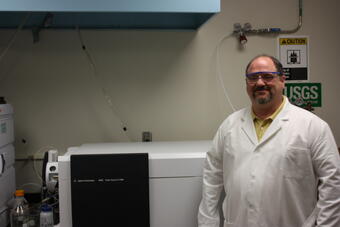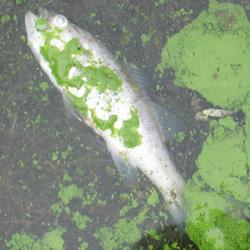USGS Scientist Receives Award for Assistance with National Wetlands Assessment
Awardee Dr. Keith A. Loftin in a Laboratory
U.S. Geological Survey (USGS) scientist Dr. Keith A. Loftin received the U.S. Environmental Protection Agency (EPA) Office of Water's Achievement in Science and Technology Award for his contributions to the National Wetlands Condition Assessment.

USGS scientist, Dr. Keith A. Loftin, received the EPA Office of Water's Achievement in Science and Technology Award. Dr. Loftin was recognized for development of pioneering methods and metrics related to algal toxins that were used in the first qualitative condition assessment of the nation's wetlands.
The assessment was presented in the EPA report National Wetland Condition Assessment 2011—A Collaborative Survey of the Nation's Wetlands. Dr. Loftin and the scientists at the USGS Organic Geochemistry Research Laboratory in Lawrence, Kansas, assisted the EPA with study design, methods development, and sample analysis of microcystins (toxins produced by cyanobacteria). The report is the first national evaluation of wetlands for microcystins. The team of scientists determined that microcystins were only present at elevated levels in a few cases in fresh, brackish, and coastal wetlands.
The USGS is doing national and regional scale assessments of the presence of algal toxins in lakes, reservoirs, ponds, rivers, and wetlands. The broader research goals include determination of factors related to cyanotoxin production and factors that may affect or create new environmental pathways of cyanobacteria that lead to human and ecological exposure.
Reference
U.S. Environmental Protection Agency, 2016, National Wetland Condition Assessment 2011—A collaborative survey of the Nation's wetlands: U.S. Environmental Protection Agency EPA-843-R-15-005, 105 p.
See below for related research.
Toxins and Harmful Algal Blooms Science Team
Program Scientist Receives Meritorious Service Award
Two Scientists Receive Early Career Excellence in Leadership Award
Cyanobacterial (Blue-Green Algal) Blooms: Tastes, Odors, and Toxins
New Study on Cyanotoxins in Lakes and Reservoirs Provides Insights into Assessing Health Risks
Importance of Lake Sediments in Removal of Cyanobacteria, Viruses, and Dissolved Organic Carbon
U.S. Geological Survey Scientists Complete First Systematic Regional Survey of Algal Toxins in Streams of the Southeastern United States
Remote Sensing Provides a National View of Cyanobacteria Blooms
Algal Blooms Consistently Produce Complex Mixtures of Cyanotoxins and Co-Occur with Taste-and-Odor Causing Compounds in 23 Midwestern Lakes
Below are news stories associated with this project.
U.S. Geological Survey (USGS) scientist Dr. Keith A. Loftin received the U.S. Environmental Protection Agency (EPA) Office of Water's Achievement in Science and Technology Award for his contributions to the National Wetlands Condition Assessment.

USGS scientist, Dr. Keith A. Loftin, received the EPA Office of Water's Achievement in Science and Technology Award. Dr. Loftin was recognized for development of pioneering methods and metrics related to algal toxins that were used in the first qualitative condition assessment of the nation's wetlands.
The assessment was presented in the EPA report National Wetland Condition Assessment 2011—A Collaborative Survey of the Nation's Wetlands. Dr. Loftin and the scientists at the USGS Organic Geochemistry Research Laboratory in Lawrence, Kansas, assisted the EPA with study design, methods development, and sample analysis of microcystins (toxins produced by cyanobacteria). The report is the first national evaluation of wetlands for microcystins. The team of scientists determined that microcystins were only present at elevated levels in a few cases in fresh, brackish, and coastal wetlands.
The USGS is doing national and regional scale assessments of the presence of algal toxins in lakes, reservoirs, ponds, rivers, and wetlands. The broader research goals include determination of factors related to cyanotoxin production and factors that may affect or create new environmental pathways of cyanobacteria that lead to human and ecological exposure.
Reference
U.S. Environmental Protection Agency, 2016, National Wetland Condition Assessment 2011—A collaborative survey of the Nation's wetlands: U.S. Environmental Protection Agency EPA-843-R-15-005, 105 p.
See below for related research.
Toxins and Harmful Algal Blooms Science Team
Program Scientist Receives Meritorious Service Award
Two Scientists Receive Early Career Excellence in Leadership Award
Cyanobacterial (Blue-Green Algal) Blooms: Tastes, Odors, and Toxins
New Study on Cyanotoxins in Lakes and Reservoirs Provides Insights into Assessing Health Risks
Importance of Lake Sediments in Removal of Cyanobacteria, Viruses, and Dissolved Organic Carbon
U.S. Geological Survey Scientists Complete First Systematic Regional Survey of Algal Toxins in Streams of the Southeastern United States
Remote Sensing Provides a National View of Cyanobacteria Blooms
Algal Blooms Consistently Produce Complex Mixtures of Cyanotoxins and Co-Occur with Taste-and-Odor Causing Compounds in 23 Midwestern Lakes
Below are news stories associated with this project.








